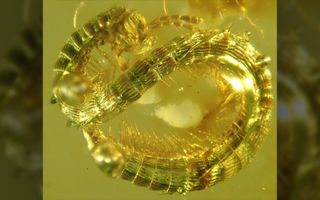Ancient Millipede Walked with Dinosaurs, Died in a Sticky Trap

About 99 million years ago, a Cretaceous millipede scampered over the forest floor in what is now Southeast Asia. The arthropod successfully avoided being squished by neighboring dinosaurs, but it had the bad fortune to stumble into a sticky patch of sap, which hardened around the millipede and locked it into an amber tomb.
While that was a terrible outcome for the millipede, it was great news for the scientists who recently discovered the tiny corpse.
The entombed fossil, of a female measuring 0.3 inches (8.2 millimeters) in length, was so well-preserved that its minuscule body structures were retained in exceptional condition. This enabled scientists to identify the tiny arthropod as not only a previously unknown species, but a previously unknown suborder as well, adding a branch to the millipede family tree. [Fabulous Fossils: Photos of the Earliest Animal Organs]
Using micro-computed X-ray tomography (micro-CT) scans, the scientists constructed a digital 3D model of the millipede, which was curled into an "S" shape inside the lump of amber. The creature had 35 body rings and fully developed sperm-storing sacs on its underside, which confirmed that the female specimen was a mature adult, the study authors said.
Today, millipedes are abundant and diverse, with about 11,000 species identified and as many as 80,000 species estimated to exist worldwide, the researchers said in a new study. But little is known about fossil millipedes, and there are only a handful of experts worldwide investigating this group, said lead study author Pavel Stoev, a professor of zoology at the National Museum of Natural History, Sofia in Bulgaria.
Evidence in the fossil record shows that millipedes were around as early as 315 million to 299 million years ago, with some growing to nearly 8 feet (2 meters) in length, Stoev told Live Science in an email.
"Prior to our study, there were only four species of millipedes described from Burmese amber, which is known to be among the oldest and richest amber deposits of Cretaceous fauna," Stoev said.
Sign up for the Live Science daily newsletter now
Get the world’s most fascinating discoveries delivered straight to your inbox.

Other than the millipede's unusually small size, several clues told the scientists that this specimen differed from the three other suborders within the Callipodida order. It lacked certain hair-like growths; the shape of its rear segment was unique, and while most callipodidans' compound eyes contain at least 30 optical units, the little millipede's eyes held only five — "the lowest limit known in the group," Stoev said.
The researchers named a new suborder, Burmanopetalidea, and dubbed the arthropod Burmanopetalum inexpectatum. The first part of that name references where the amber came from — Burma, now Myanmar — while "inexpectatum" is Latin for "unexpected," celebrating the surprise discovery of a new millipede suborder, according to the study.
The findings were published online today (May 2) in the journal Zookeys.
- Photos: Ancient Ants & Termites Locked in Amber
- Amber Trap Nabs Feathered Dino Tail (Photos)
- Hatchling Preserved in Amber (Photos)
Originally published on Live Science.

Mindy Weisberger is an editor at Scholastic and a former Live Science channel editor and senior writer. She has reported on general science, covering climate change, paleontology, biology, and space. Mindy studied film at Columbia University; prior to Live Science she produced, wrote and directed media for the American Museum of Natural History in New York City. Her videos about dinosaurs, astrophysics, biodiversity and evolution appear in museums and science centers worldwide, earning awards such as the CINE Golden Eagle and the Communicator Award of Excellence. Her writing has also appeared in Scientific American, The Washington Post and How It Works Magazine.
Most Popular

